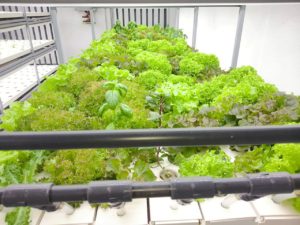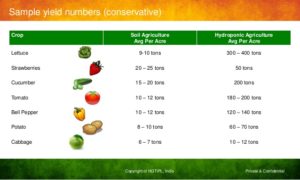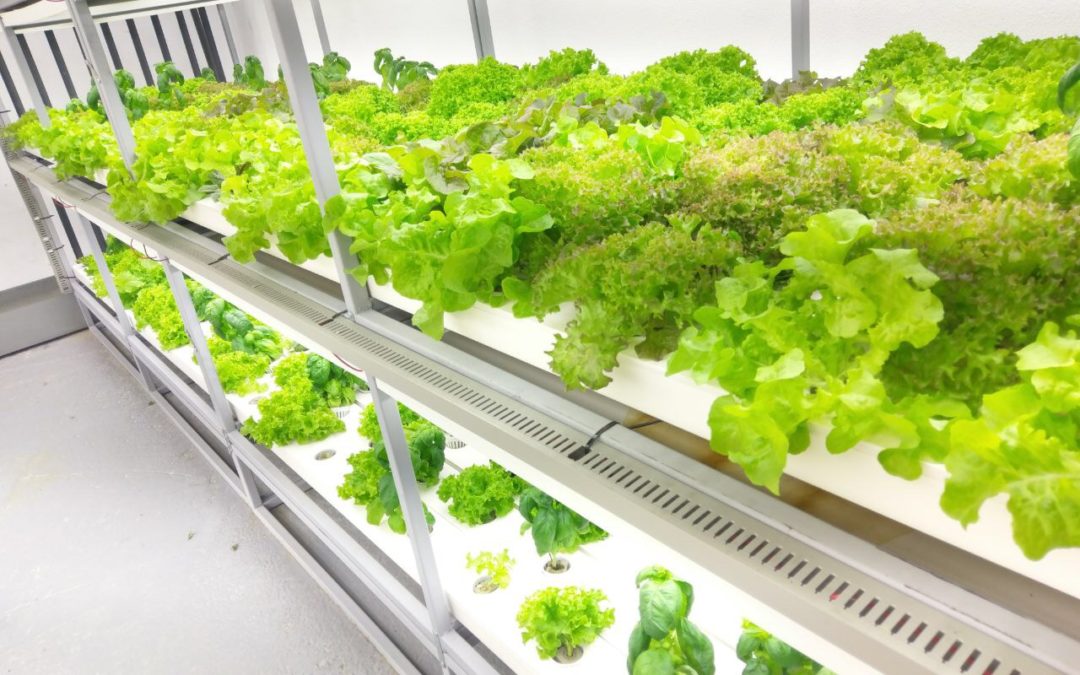We talked to Ali Makhzoum, co-founder of LifeLab, to have his in-depth insight on the hydroponics sector, the solutions LifeLab is providing and where it stands in the international scene.
LifeLab provides the world’s smallest turnkey vertical hydroponic modules. These modules connect to each other and then ultimately to an industrial grade automation system that runs the entire grow process with very little human intervention. LifeLab joined the Agrytech Accelerator Batch I in the Bootcamp and Acceleration phases. Their work with the Agrytech team continues.
Q: What are the specificities of your hydroponics system?
A: It’s 2 things: 1) Modularity: Our systems are modular, and I’m not talking about a 20-ft container module, but a 0.5 cubic meter module, which makes our LiveCube™ system the smallest, and hence, most flexible, vertical hydroponic module in the world, and it’s specifically designed for commercial (B2B use).
Besides its modularity factor, we’ve technically invented a new measurement unit in the world of commercial agro production to highlight the benefits of vertical farming. People still measure in square meters, we measure in LiveCubes, factoring in the entire volume of any given farm space instead of only its area. 2) Hybrid Technique: Loosely based around NFT (Nutrient Film Technique), yet surpassing it by drawing on the strong points of several other hydroponic growing methods, our technology is a hybrid model that combines the best parts from each known technique, and adds our own magic touch to them to create a robust, dependable growing environment that maximizes the advantages and minimizes the known disadvantages/weaknesses of hydroponics.
Q: What are the elements of the a LifeLab solution?
A: Our solution is a 360-degree approach that aims at tackling the entire farm-to-fork chain. It’s composed of 3 parts:
I) The Physical Tech: This is the actual farm, composed of the combination of our proprietary modules and their governing control mechanism in which the plants grow: BaseCube™ modules + LiveCube™ modules + Command & Control Module = LifeLab UpFarm™
II) The LifeLine™ Dashboard: To control quality (and generate recurring income) we supply the farms with everything they need to grow their produce. Currently this is a simple on-the-ground system whereby customers order the supplies they need and we deliver them, but we’re developing it into an online dashboard connected to the farm, that tracks the operators inventory (plugs, seeds, nutrients, and all other growing supplies) and connects to our supply system to inform the farmer/operator, and us, of current inventory levels and imminent requirements, which will enable the farmer/operator to automatically replenish their inventory with great ease.
III) The ‘Community’ OTMP (Online Trade Management Platform): This is a fully online platform currently in early phases of design, which will be composed of a virtual marketplace, connecting our operators/producers directly to buyers.
Q: Is anyone else working on something similar in Lebanon?
A: That really depends on what you mean by “similar”. We come across new attempts at commercial hydroponic farms on a weekly basis. All of them are set up within traditional greenhouses, which constitute a very poor environment for hydroponics and an even poorer one for vertical growing since they depend on sunlight coming from a single source at the highest point of the structure, leaving the lower layers partially or completely shaded. Not to mention the insects, and radical environmental changes with the change of the external climate, which totally defeats the purpose of CEA (controlled environment agriculture).
Q: How does LifeLab’s innovation compare to international solutions in hydroponics?
A: Besides the small handful of global players with the right idea in mind, most international attempts are focusing either on B2C grow-your-own food-on-your-bookshelf- type products, which is not our market, or on “Urban farming”, which is nice in theory but ridiculously unsustainable in reality.
Because of their modularity and flexibility, our systems can thrive anywhere, particularly in suburban and rural areas, where actual farmers are more likely to be available. Even if the investors behind the farms were large food companies, which fits quite well into our business model, you still need farmers with green thumbs to run these places. So we’d be creating a new breed of partnerships.
Literature aside, and on a more technical note, there are generally two types of hydroponic technologies in the world: Very high tech, very expensive, high maintenance, good results, but terrible payback period, and there’s the low tech, less expensive, low maintenance model set up in traditional greenhouses, which is significantly less productive, problem-ridden, and yields average to mediocre results.
From day one, our goal was to optimize vertical hydroponics for commercial feasibility, and we did exactly that. Our technology strikes the perfect balance between the available options, bringing together the best of both worlds: Robust, dependable technology that’s designed around the most important aspect of the farm: The farmer/operator.
Our technology is a well rounded combination of hardware, software, and intuitive design; sophisticated enough to automate most of the work saving over 75% of the labor otherwise required, yet simple and practical enough to allow easy operation and still allow the farmer/operator their own input and personal touch into the process, putting their growing experience to good use, resulting in a seamless combination of human know-how and experience on one hand, and technology that does the heavy lifting on the other hand; creating standard, predictable results with a payback period that trumps the competition by years, not months.
(The smallest LifeLab UpFarm yields 100% ROI in 2.3 years with OPEX included, this period goes down as the area of the farm increases; compared to ~4.5 years for our closest European Competitors “Urban Crop Solutions” and 8.8 years for our closest American Competitor “Freight Farms” – based on CAPEX alone. I’m not even going to bring up the Japanese competition because then it just gets embarrassing, but just for your reference: Japanese Container Farms – Qatar listen for the price in the first few seconds of commentary).
Q: What are the setup costs vs revenue compared to conventional farming?
A: A traditional plastic greenhouse costs less than $100 per square meter to set up without any sophisticated features, and depending on climate and availability of water, the operational cost varies, rendering the average COGS (cost of goods sold) per plant at around 25 cents, not factoring in the pesticides/herbicides or labor required to run the operation which would drive the cost up even more.
Produce from such a greenhouse would be considered gourmet if the plant sells for $1, which is rarely the case as most local farmers sell their greens at 60-75 cents per plant and are restricted by seasonality, which means they can produce 3-4 harvests a year on average for most types of crops.
Compare that to one of our farms, where one square meter costs approximately $1,000 to set up (at 5 levels; 3M height) , and around 30 cents COGS per plant, produces the equivalent of 30 Square Meters, 365 days a year, with near zero crop losses. No pests, no weeds, and hence no pesticides or herbicides.
90% less water consumption. Fully climate controlled which means they can be used to grow produce specifically when it’s out of season, and sell it for premium prices, and when said produce gets back in season and the competition increases, our farmers/operators can immediately switch (within 24 hours) to producing whatever else has now gone out of season and sell THAT at a premium price when nobody else around them can grow it.
Q: Who is your target market? Who are you planning to sell your product to?
 A: At first we wanted to target traditional farmers. Needless to say that didn’t fly. However, their educated children who are now doctors, engineers…etc and have inherited the family land/business are loving the concept of a farm that fits in a small space, operates year-round, produces 30 times as much in a fraction of the time (4 hours a day instead of 10-12), a fraction of the labor, and requires no tractors/harvesters/other heavy machinery, weeding, dirty work or heavy lifting, controlled by a touchscreen and can be monitored from anywhere through their smartphones. This allows them to invest their savings in a family business that makes them several times the profit their fathers used to make while still keeping their jobs.
A: At first we wanted to target traditional farmers. Needless to say that didn’t fly. However, their educated children who are now doctors, engineers…etc and have inherited the family land/business are loving the concept of a farm that fits in a small space, operates year-round, produces 30 times as much in a fraction of the time (4 hours a day instead of 10-12), a fraction of the labor, and requires no tractors/harvesters/other heavy machinery, weeding, dirty work or heavy lifting, controlled by a touchscreen and can be monitored from anywhere through their smartphones. This allows them to invest their savings in a family business that makes them several times the profit their fathers used to make while still keeping their jobs.
Besides these individual neo-farmers, we want to target a wide range of F&B companies, supermarket chains, and governmental agencies specialized in agro-development & subsidization. In the future, we can create private-sector consotrium-type cooperatives, where we pair investors with farmers. The investors put in the money, the farmer operates the farm and is a partner, our system handles the rest, and everyone makes money.
Our GTM strategy involves creating strategic partnerships with existing companies (mainly agriculture equipment/supplies providers) who’s staff we would train to handle sales and maintenance on our behalf using their already existing infrastructure instead of us investing heavily in every new geography/market we want to penetrate.
Q: What is the dollar value of the hydroponics sector internationally?
A: Global Annual Fresh Produce Imports:
MENA: $92.4 Billion
USA: $70 Billion
Europe: $45 Billion
Global Hydroponics Market (2017):
Equpiment & Supplies: $ 340 Million
Produce Market: $ 114 Billion
Medical Cannabis: $ 52 Billion
Q: Where are you now? Where are you planning to be? What do you need to achieve that?
A: We recently finished our very intensive foundation phase of R&D and product + market validation. Our technology has been installed and performing very well for over 2 years now, we did all the necessarily polishing & debugging to have a viable, commercially feasible, market-ready product that can produce 70+ types of greens as well as strawberries* with very stable and predictable results. It’s now time for us to start selling our first product and capitalize on all the product development we’ve done over the past few years.
While starting to sell our first product, we want to be working in parallel on developing our second hardware product, the OmniHive™, which is a vertical hydroponic system capable of growing everything else our current product (and all our global competitors products) cannot grow: 40+ varieties of fruiting plants, berry bushes, and dwarf fruit trees.
To achieve all that we need a new, sizeable round of funding, and a network of strategic partners to help us achieve our goals.
Watch Ali’s video
Agrytech is a program by Berytech jointly funded by Berytech and the Embassy of the Netherlands in Lebanon. Applications are now open for Batch II of the Agrytech Accelerator.




